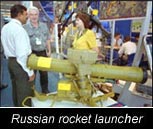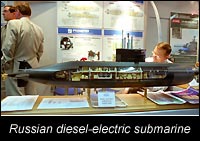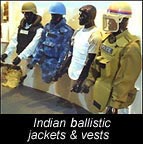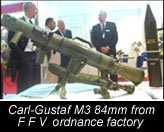


Deep Throat, the legendary, still unknown contact of the two Washington Post reporters on the trail of Watergate, doesn't seem to enjoy much popularity among Delhi reporters.
Or so it seemed from the dull media coverage of the second International Defence Exhibition in New Delhi, February 19-23.
If reporters had followed the money, as Deep Throat advised, there was no place other than Pragati Maidan, where Defexpo was in progress, for them to land up on those days.
There was too much money. Even the smallest exhibitor was talking in terms of millions. And a billion dollars was an ordinary sum that you heard here, there and everywhere during the exhibition.
The second international exhibition of defence products in India was at worst a grotesque display of mankind's destructive capabilities. At best, it was an impressive array of the world's biggest industry's best products, and an attempt by arms dealers and producers to sell as much as possible to a very thirsty Indian defence forces.
 The India-Pakistan standoff is still being played along the border, and the army has been building up a long list of deficiencies.
The India-Pakistan standoff is still being played along the border, and the army has been building up a long list of deficiencies.
There isn't another industry, another sector where even the smallest of purchases usually costs a few million dollars. Yet it is possibly the only sector where governments have their purse strings loose.
The defence sector is an amazing, vast and mind-boggling area. It is mysterious, with a stinking underbelly of arms agents having networks in the underworld as well as the ruling elite.
An exhibition of defence products is a unique festival of some of the best researchers, richest manufacturers and most ruthless dealers of the world's biggest industry.
It is amidst such a milieu that tanks, guns, rocket-launchers, miniature submarines, bulletproof jackets, missiles and some dated weaponry of Indian origin were all displayed at Pragati Maidan.
In the maddening world of weapons, there are no friends and enemies: only potential customers. So Russian companies and American firms exhibit a feet apart, also inadvertently exhibiting their common aim, and post-Cold War warmth and challenge: to sell accumulating weapons, to find new markets.
 There is no embarrassment, no apologies when it comes to defence sales. Bofors, now renamed SWS Defence AB, was there to exhibit its latest upgrade of the 155mm howitzers even as the case of corruption during the purchase of the same guns in the late 1980s still continues. And the jinx still haunts the Congress party.
There is no embarrassment, no apologies when it comes to defence sales. Bofors, now renamed SWS Defence AB, was there to exhibit its latest upgrade of the 155mm howitzers even as the case of corruption during the purchase of the same guns in the late 1980s still continues. And the jinx still haunts the Congress party.
At the exhibition ground, the worst of the competition between arms dealers was visible in the aviation sector, where companies are jostling to capture India's contract worth more than a billion dollars for advanced jet trainers.
The government was in the final stages of negotiating with British Aerospace for the Hawk AJT. And then came the exhibition, with its new offers.
India's haggling with BAe over the cost of the AJT is no secret. So, a Czech company stepped in a few days before the Defexpo with massive newspaper advertisements, offering AJTs for a much cheaper rate. During the Defexpo came another Israeli company, offering yet again a cheap AJT. And then there were the Russians too, offering their MiG AJTs.
The final result of the jockeying could be that the AJT deal is stuck yet again. The government has realised that if it goes ahead with the Hawk AJT purchase at this juncture, the opposition has a ready scandal in hand. A scandal that would dwarf even Bofors.
"How can we now not take a look at the other AJTs being offered?" a senior bureaucrat in the defence ministry wondered. "The offers may take us back to square one on the AJT deal."
 It is now almost two decades since India began looking for AJTs, which help to drastically reduce human error, especially among young pilots, when they begin to fly tough fighters such as MiG-21s.
It is now almost two decades since India began looking for AJTs, which help to drastically reduce human error, especially among young pilots, when they begin to fly tough fighters such as MiG-21s.
While the facilitation of new contacts between companies has been a great contribution by the exhibition, its ability to throw up truants cannot be ignored.
Sometimes, it led to really embarrassing situations.
Here is one: After inaugurating the exhibition, Defence Minister George Fernandes said the government would be setting up an ordnance factory at Nalanda, his constituency in Bihar.
But as the exhibition progressed, a couple of foreign countries, including the South Africans, claimed that they were in the final stages of entering into a joint venture at Nalanda. There was no response from the Ordnance Factory Board, which anyway looked dated and almost out of place among the modern, hi-tech international companies.
The OFB had a massive display site, but very little to attract "customers". For the diehard patriotic Indians, the OFB gave a chance to have a close look at the equipment, weapons and dresses that the Indian soldier uses.
The Defence Research and Development Organisation, on the other hand, made a pitched effort to attract foreign customers, especially companies for collaborations. With a slick exhibition hall and specially created signature music, the DRDO stall was impressive. Among the items to attracted much attention was the recently developed Brahmos, India's first supersonic cruise missile.
The DRDO also had on display a self-propelled gun, combining a South African gun top on an Indian tank chassis. There isn't any clear indication yet, however, if the DRDO has managed to find any collaborators or potential customers from the rest of the world.
 There were several Indian private companies too. In the new scenario in which the defence sector has been opened up to private investment, with a 26 per cent cap on foreign direct investment, they were a noticeable presence.
There were several Indian private companies too. In the new scenario in which the defence sector has been opened up to private investment, with a 26 per cent cap on foreign direct investment, they were a noticeable presence.
But they were not the happiest lot.
A senior executive with Mahindra Defence Systems complained: "We are ready to get further involved in producing defence products, but several archaic laws still give the public-sector units an edge."
There are laws, for instance, that prohibit paramilitary forces from purchasing a slew of products from the private sector, even if they are of better quality, the executive pointed out.
Still, MDS exhibited India's first truly bulletproof vehicle, which will soon be visible in large numbers in the Kashmir valley. The army has placed orders for about 200 of them.
But despite their best efforts, Indian firms were no match to the money and technological prowess of the foreigners. Some like Thales, from France, had full-fledged media managers flown down from their headquarters. And they would often call correspondents from their international roaming mobile phones, where we were just a local call away. That is the extravagance of the defence industry.
It was not just submarines, fighters, ships and guns that were on display. Almost everything one could imagine was there.
 Swiss army knife manufacturer Victorinox was at the exhibition. They dream that one day their beautiful knives will be in the pocket of every Indian soldier, as a personal tool on the battlefield. Imagine an order for over a million knives!
Swiss army knife manufacturer Victorinox was at the exhibition. They dream that one day their beautiful knives will be in the pocket of every Indian soldier, as a personal tool on the battlefield. Imagine an order for over a million knives!
There were also companies, which produce small items, such as astonishingly small screws, nuts and bolts, and much cheaper too. Then again, it's not too difficult to make those products cheaper, considering that a few years ago an Indian Navy contract for the refit of HDW submarines awarded upwards of Rs 25,000 for a screw worth Rs 2.50. This is recorded in defence files and reported in the media.
Leaving cynicism behind, Indian armed forces need to desperately look at ways of improving domestic participation, if the country's defence preparedness is not to be held ransom to international politics. And Defexpo was a brilliant opportunity for the Indian industry to find suitable international partners to set up shop in the defence sector.
Executives of a firm near Delhi said they were looking at the possibility of manufacturing lightweight bulletproof jackets. There were several more preliminary discussions between Indian companies and international giants.
 Atul Kirloskar, chairman, defence committee of the Confederation of Indian Industry, said "defence production is an emerging arena" and for Indian industry the exhibition provided a wonderful opportunity to interact with potential international contributors.
Atul Kirloskar, chairman, defence committee of the Confederation of Indian Industry, said "defence production is an emerging arena" and for Indian industry the exhibition provided a wonderful opportunity to interact with potential international contributors.
He said the second Defexpo -- the first was held in 1999 -- had witnessed a major surge in interest. This year, more than 300 firms were exhibiting, while in 1999 there were only 197.
In 1999 there were industries from only 12 countries, but this time there were 19 countries. And most of the 25 country delegations were led by their trade ministers.
Kirloskar said it would take some time for Indian private entrepreneurs to begin investing in defence production.
Defence Production and Supplies Secretary Subir Dutta said that on an average about Rs 100 billion worth of foreign purchases are made by the Indian armed forces in a year.
And that is certainly a huge market.
Photographs: Ranjan Basu/Saab Press
The Rediff Specials